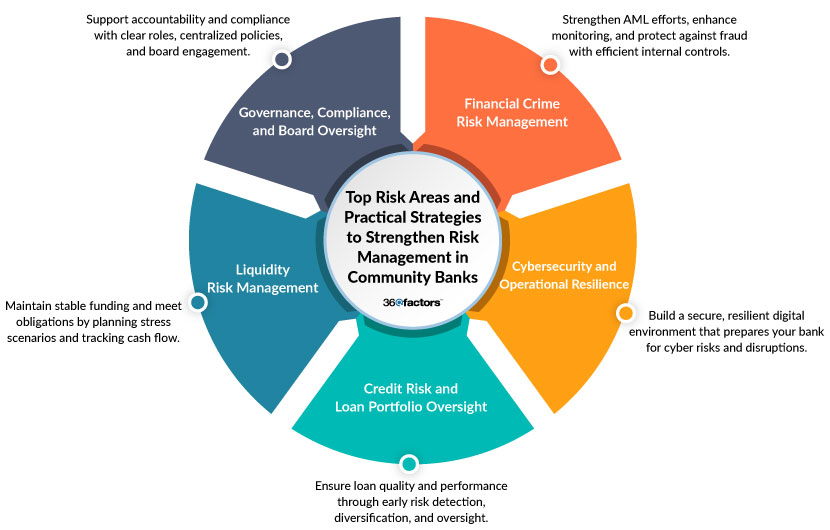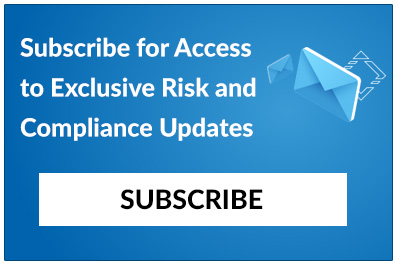Home/ Blog / Implementing Leading Strategies for Effective Risk Management in Community Bank
Community banks’ risk management is under increasing pressure as they face heightened scrutiny from regulators across several key areas, including financial crime, cybersecurity, credit exposure, liquidity planning, and governance. Enforcement actions increasingly focus on compliance failures, weak risk oversight, and gaps in internal controls. This makes it essential for banks to adopt visible and effective risk management practices.
For many community banks, the pressure to improve risk management processes comes with limited resources. Expanding teams or engaging external consultants isn’t always feasible. Yet, managing risk with disconnected tools, scattered data, and ad hoc processes creates blind spots that can lead to costly consequences. The need for streamlined, well-executed strategies has never been greater.
This blog offers practical insights to enhance community bank risk management without requiring additional staff or relying on fragmented solutions. From financial crime to liquidity stress testing and board oversight, each section offers actionable steps tailored to the operating realities of small business banks. It also explores how a fit-for-purpose solution can help unify risk efforts and support regulatory readiness with greater confidence and control.
Priority Risk Areas and Strategies for Effective Risk Management in Community Banks

1. Financial Crime Risk Management
Financial crime involves anti-money laundering efforts, customer identification practices, transaction scrutiny, and compliance with suspicious activity reporting rules. The approaches discussed below are critical to community bank risk management, particularly in mitigating financial crime exposure and risk.
Strategies to Improve Financial Crime Controls
Modernize Monitoring Capabilities
Replace manual reviews with automated processes that flag anomalies in real-time. This speeds up detection and improves reporting accuracy.
Establish Regular Audit Cycles
Conduct targeted internal reviews to assess program design and control effectiveness. Use findings to refine procedures and address weaknesses promptly.
Deliver Role-Based Training
Equip employees with the knowledge they need, tailored to their specific responsibilities. Maintain clear training records to demonstrate readiness and reinforce accountability.
Keep Customer Data Current
Periodically update client profiles, especially for higher-risk segments. Enhanced due diligence ensures a more accurate understanding of customer behavior and potential risk.
2. Cybersecurity and Operational Resilience
Cybersecurity covers the safeguarding of information systems, preparation for cyber incidents, and continuity of operations in the face of disruptions for small business banks.
Strategies for Strengthening Cyber Defenses
Follow Recognized Frameworks
Structure your community bank’s risk management program around established standards that guide cyber risk identification, response planning, and control measures.
Test Plans, Don’t Just Draft Them
Routine simulations of cyberattacks or outages help verify the effectiveness of your response and recovery plans.
Evaluate Vendor Security Posture
Perform due diligence before engaging with service providers. Establish clear expectations around data protection and incident disclosures.
Build a Security-Conscious Workforce
Conduct recurring awareness sessions and simulated attacks to improve employee vigilance. Encourage timely reporting of errors.
3. Credit Risk and Loan Portfolio Oversight
This area involves managing exposure to borrower risk, diversifying loan portfolios, and implementing oversight mechanisms to ensure loan performance and credit quality. Effective credit risk oversight is a central pillar of community bank risk management , supporting both asset stability and long-term profitability.
Strategies to Enhance Credit Risk Oversight
Incorporate Scenario Testing
Run simulations to examine how borrower defaults or economic shifts could impact loan health. Use results to calibrate policies.
Set Sensible Exposure Limits
Monitor sector and geographic concentrations to avoid excessive reliance on any single borrower type or market condition.
Use Data to Spot Risk Early
Implement indicators that detect performance deterioration, allowing for timely engagement with at-risk borrowers.
Maintain Clear Oversight Protocols
Keep detailed records of policy exceptions, loan review findings, and management responses to support internal transparency.
3. Liquidity Risk Management
Liquidity management involves ensuring sufficient cash or access to funding is available to meet small business banking obligations under normal and stressful conditions. It is an essential part of community bank risk management, helping institutions remain stable and responsive during periods of financial uncertainty.
Strategies to Improve Liquidity Control
Design Realistic Stress Tests
Examine how your liquidity position would respond to adverse events, such as shifts in deposits or rising funding costs.
Keep Contingency Plans Active
Periodically review and update contingency strategies. Confirm that backup funding sources and operational steps are clearly defined.
Inform Leadership Early
Establish reporting channels for timely updates on liquidity indicators. This supports rapid response and board oversight.
Track Flows in Real Time
Use tools that continuously monitor cash movements and funding availability. Real-time visibility is critical during volatile conditions.
5. Governance, Compliance, and Board Oversight
This domain focuses on the structure and clarity of compliance responsibilities, the board’s involvement in risk oversight, and the maintenance of policies and controls across the institution. Strong governance and board oversight are essential to community bank risk management, ensuring accountability, regulatory alignment, and an effective risk management process across all operations.
Strategies to Reinforce Governance Standards
Clarify Leadership Roles in Oversight
Define how compliance information flows to the board. Ensure leadership understands its role in setting priorities and evaluating risk reports.
Centralize Policy Documentation
Store compliance policies, role definitions, and issue tracking data in one system. This supports consistency and eases exam preparation.
Use Executive Dashboards
Present risk trends and control effectiveness visually to the board and senior executives. Dashboards enable informed decision-making without excess detail.
Link Internal Reviews to Board Agendas
Coordinate mock exams, audit findings, and risk assessments with board schedules to support timely action and improve regulatory posture.
Why a Modernized Risk Management Platform is Paramount
Effectively managing risk across financial crime, cybersecurity, credit, liquidity, and governance demands more than isolated checklists or disconnected tools. As regulatory expectations grow more complex, the need for a unified, real-time view of risk becomes essential for community bank risk management.
Yet, many community banks still rely on manual processes, fragmented spreadsheets, or dated tools that limit visibility and delay responses. This approach creates operational blind spots, increases audit complexity, and puts institutions at a disadvantage during regulatory reviews.
To address these challenges, the best small business banks implement a modern, right-sized risk management solution that unifies assessments, issue tracking, and reporting. This integrated approach replaces fragmented tools, improves visibility, and enables faster responses to emerging risks. With standardized assessments, centralized data, and automation, banks can reduce manual effort, strengthen audit readiness, and support sound decision-making, even with limited staff. For today’s risky environment, this shift is essential to stay compliant, efficient, and resilient.
Integrate Predict360 Essentials for Effective Risk Management in Community Bank
The effective community bank risk management strategies outlined throughout this blog highlight a clear theme: success depends on consistency, visibility, and timely execution. For the best small business banks, achieving that level of control is challenging when following traditional processes. What is needed is a purpose-built risk management solution that brings risk and issues management together in a streamlined system.
Predict360 Essentials delivers exactly that. Designed specifically for U.S. community banks with under $3 billion in assets, this right-sized solution replaces fragmented tools with standardized, preloaded risk assessments across key areas like BSA/AML, cybersecurity, and fair lending. It enables banks to assess, document, and report risks more accurately and efficiently. Real-time issue tracking ensures timely remediation, while Kaia, Predict360’s AI companion trained in financial risk and compliance knowledge, helps teams identify relevant controls, streamline workflows, and make smarter decisions.
Request a Demo
Complete the form below and our business team will be in touch to schedule a product demo.
By clicking ‘SUBMIT’ you agree to our Privacy Policy.



